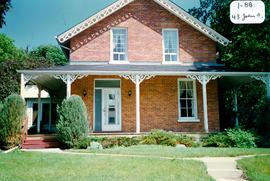- CA BWGPL GJ-HB-2017-04-05-01
- Item
- 1996
Part of George Jackson fonds
The mid-block building located on the north side at 93 John Street East was built pre-1900 in the Gothic Revival Cottage style. A large horse stable and a barn for storing marsh hay once stood behind the house. A fence also ran across the length of the rear of the property. Brunnetto Caesar lived here with his wife Grace (Stamper). He worked on the marsh harvesting marsh hay and as a teamster. He later bought a tractor and did custom work (draining and breaking marshland). Bill Wilson and his wife bought the house after World War II. He worked on the railway and retired here. He had a large garden at the rear, as well as a barn. Bill eventually sold the house to Ferrara and moved away.
The 1½-storey, three-bay house has a rectangular plan with a centre hall, a symmetrical façade with a centre gable over the entrance, and a medium-pitched, gable roof. The entrance porch does not appear to be original because the peak and eaves of the hip roof of the porch interfere with the ground and second-floor windows. Double-hung windows are set into rectangular openings with plain, wood frames and sills. The house has wood frame construction, stucco cladding, and a parged, stone foundation. According to the 2000 inventory, the main-floor windows, screen door, and the two-storey addition at the rear are not original. (1, 2, 3)
Please contact the Bradford West Gwillimbury Public Library (905-775-3328) if you have any other information about this photo.
George Jackson




